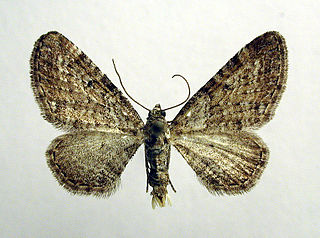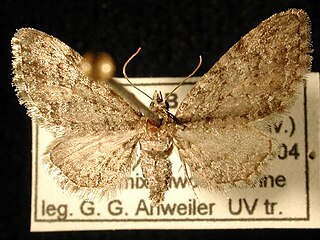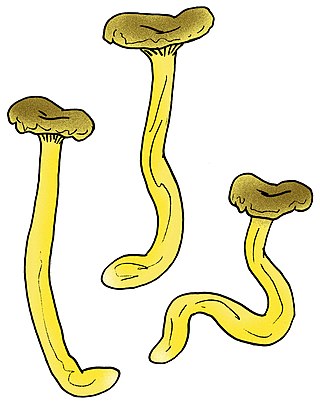
The juniper pug or juniper looper is a moth of the family Geometridae. The species was first described by Michael Denis and Ignaz Schiffermüller in 1775. It is found throughout the Palearctic and in the Nearctic.
The Chinese scrub vole, or Irene's mountain vole, is a species of rodent in the family Cricetidae. It is endemic to mountainous parts of southern China and is very similar to the Sikkim mountain vole in appearance. The International Union for Conservation of Nature has assessed its conservation status as being of "least concern".

Eupithecia simpliciata, the plain pug, is a moth of the family Geometridae. It is found in the Palearctic realm, from western Europe to north-western China (Xinjiang). The species primarily colonizes wastelands, rubble and abandoned vineyards, and in Asia also salt steppes. In the Alps, the range of altitude extends up to 1200 metres.

Eupithecia groenblomi is a moth of the family Geometridae. It is known from Europe and Asia. In Europe, it occurs in Norway, Finland and northwestern Russia and the Urals. In Asia, it is known from the Russian Far East, the Kuril Islands, Japan and China.

Eupithecia pernotata, or Guenée's pug, is a moth of the family Geometridae. The species was first described by Achille Guenée in 1857. It is known from the Alps, through Romania to southern Russia. It is also found in Finland.

Eupithecia pimpinellata, the pimpinel pug, is a moth of the family Geometridae. The species was first described by Jacob Hübner in 1813. It is known from most of Europe to Morocco, Siberia, Kyrgyzstan, Altai, Mongolia.It primarily colonizes bushy places, forest edges, clearings, hedges, mountain slopes, embankments, railway dams and parks as well as semi-dry grasslands. In the Alps it rises to heights of 1800 metres.

Eupithecia pygmaeata, the marsh pug, is a moth of the family Geometridae. It is known from most of Europe, western and southern Siberia, the Russian Far East, northern Mongolia and North America .The species primarily colonizes floodplain and disused forests, bogs, river banks and marshy meadows. E. pygmaeata reaches up to 1800 meters in South Tyrol.

Eupithecia valerianata, the valerian pug, is a moth of the family Geometridae. The species was first described by Jacob Hübner in 1813. It is found from Great Britain, through central Europe to western Russia, Belarus and northern Iran.
Eupithecia amicula is a moth in the family Geometridae first described by Vladimir G. Mironov and Anthony Charles Galsworthy in 2005. It is found in south-western and western Chinese provinces of Sichuan, Yunnan and Shaanxi.
Eupithecia propagata is a moth in the family Geometridae. It is found in India, Nepal, Bhutan and China. It is on wing from late July to late October.

Eupithecia columbiata is a moth in the family Geometridae first described by Harrison Gray Dyar Jr. in 1904. It is found in North America from eastern Newfoundland and Labrador to Vancouver Island, south to North Carolina in the east and Colorado in the west. The habitat consists of deciduous and mixed-wood forests and forest edges, as well as shrubby areas.

Eupithecia stellata is a moth in the family Geometridae first described by George Duryea Hulst in 1896. It is found in North America from central Manitoba to northern Alberta and south to California and Mexico.

Eupithecia niveifascia is a moth in the family Geometridae first described by George Duryea Hulst in 1898. It is found in North America from south-western Alberta west to Vancouver Island, north to northern coastal British Columbia and south to New Mexico.
Eupithecia egena is a moth in the family Geometridae. It is found in China, India and Nepal. The species flies from mid-July to mid-September at an altitude between 1800 and 4000 meters above sea level.
Eupithecia formosa is a moth in the family Geometridae. It is found in China (Yunnan).
Eupithecia indissolubilis is a moth in the family Geometridae. It is found in the Shaanxi province of China, and in parts of Russia. It has been found at altitudes between 1100 and 1700 meters. Adults are on wing from early June to early July.
Eupithecia konradi is a moth in the family Geometridae. It is found in China (Yunnan).
Eupithecia pediba is a moth in the family Geometridae. It is found in eastern Tibet (Sichuan), and Yunnan, China. It occurs at a high altitude, between 4000 and 5000 meters above sea level, and is on wing from mid-June to mid-July.
Eupithecia perendina is a moth in the family Geometridae. It is found in China (Yunnan).

Cantharellus zangii is a species of fungus in the family Cantharellaceae. Described as new to science in 2012, it is found only in a small area in northwestern Yunnan, China. The fungus produces small, ochre to ochre-yellow fruit bodies (mushrooms) with thin flesh and a long tapering stipe. Microscopically, the mushroom features thin-walled hyphae with clamp connections, and large ellipsoid-shaped spores.










